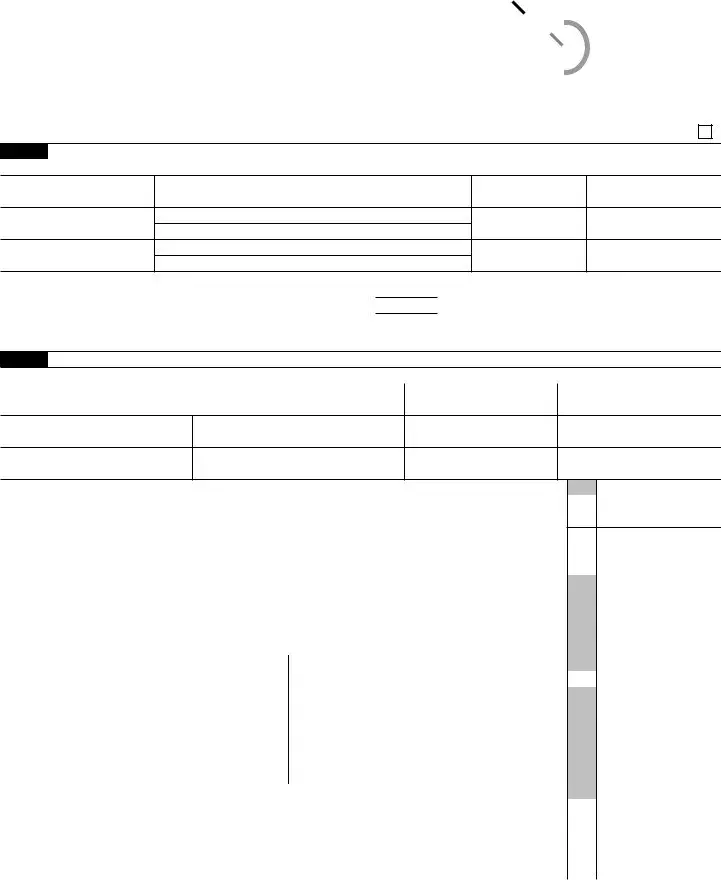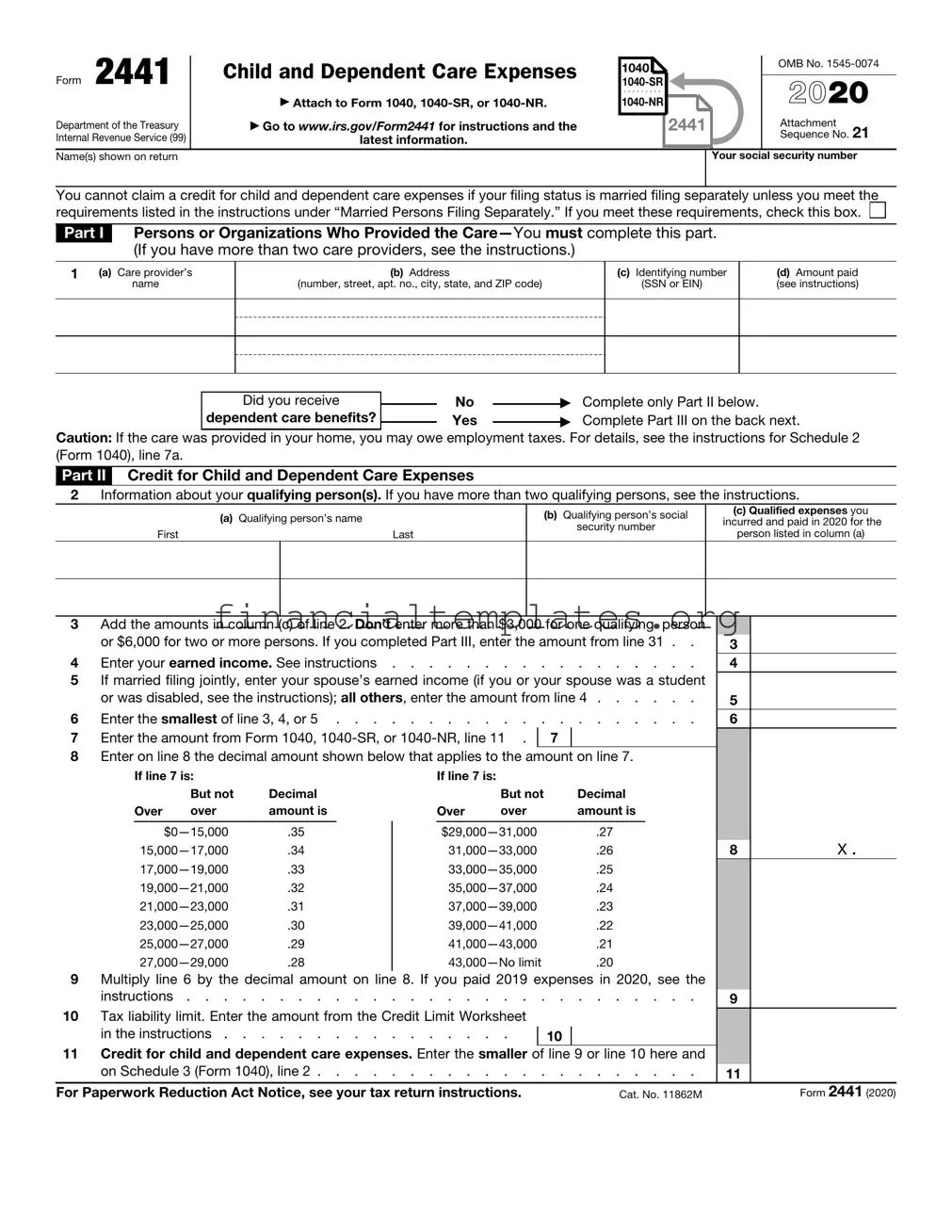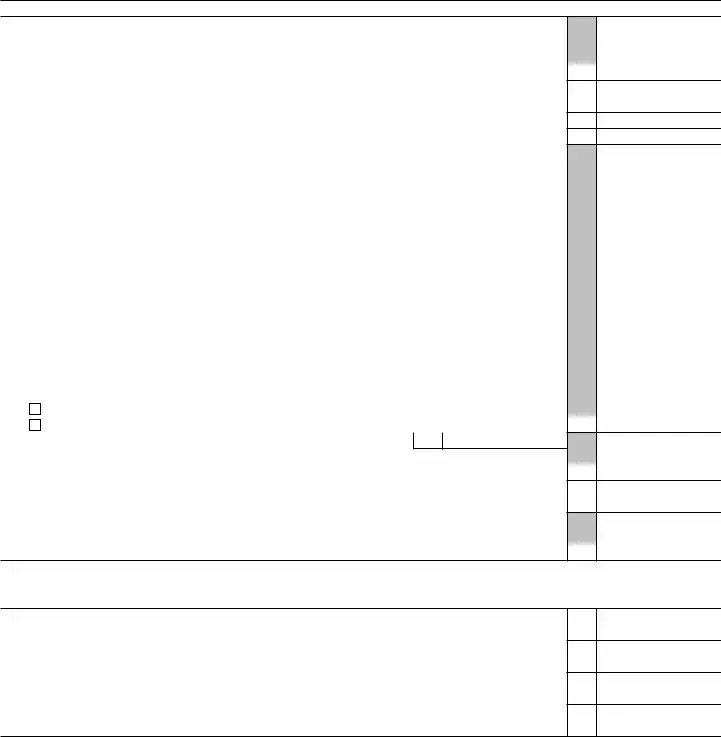
Form 2441 |
Child and Dependent Care Expenses |
1040 |
OMB No. 1545-0074 |
1040-SR ◀ |
2021 |
|
▶ Attach to Form 1040, 1040-SR, or 1040-NR. |
. . . . . . . . . |
|
1040-NR |
|
|
Department of the Treasury |
▶ Go to www.irs.gov/Form2441 for instructions and |
2441 |
Attachment |
Internal Revenue Service (99) |
the latest information. |
|
Sequence No. 21 |
Name(s) shown on return |
|
|
Your social security number |
AYou can’t claim a credit for child and dependent care expenses if your filing status is married filing separately unless you meet the
requirements listed in the instructions under “Married Persons Filing Separately.” If you meet these requirements, check this box .
BFor 2021, your credit for child and dependent care expenses is refundable if you, or your spouse if married filing jointly, had a
principal place of abode in the United States for more than half of 2021. If you meet these requirements, check this box . . .
Part I |
Persons or Organizations Who Provided the Care—You must complete this part. |
|
If you have more than three care providers, see the instructions and check this box |
1(a) Care provider’s
name
(b)Address
(number, street, apt. no., city, state, and ZIP code)
(c) Identifying number |
(d) Check here if the |
(e) Amount paid |
care provider is your |
(SSN or EIN) |
household employee. |
(see instructions) |
|
(see instructions) |
|
|
|
|
|
|
|
|
|
|
|
|
|
|
|
|
|
|
|
|
|
|
|
|
|
|
|
|
|
|
|
|
|
|
|
|
Did you receive
dependent care benefits?
No |
|
▶ |
Complete only Part II below. |
|
Yes |
▶ |
Complete Part III on page 2 next. |
Caution: If the care was provided in your home, you may owe employment taxes. For details, see the instructions for Schedule H (Form 1040). If you incurred care expenses in 2021 but didn’t pay them until 2022, or if you prepaid in 2021 for care to be provided in 2022, don’t include these expenses in column (c) of line 2 for 2021. See the instructions.
Part II Credit for Child and Dependent Care Expenses
2Information about your qualifying person(s). If you have more than three qualifying persons, see the instructions and check
this box |
. . . . . . . . . . . . . . . . . . . . . . . . . . . . . . . . . . . . . . |
(a) |
Qualifying person’s name |
First |
Last |
(b)Qualifying person’s social security number
(c)Qualified expenses you incurred and paid in 2021 for the
person listed in column (a)
3Add the amounts in column (c) of line 2. Don’t enter more than $8,000 if you had one qualifying
person or $16,000 if you had two or more persons. If you completed Part III, enter the amount |
|
from line 31 |
3 |
4 Enter your earned income. See instructions |
4 |
5If married filing jointly, enter your spouse’s earned income (if you or your spouse was a student
|
or was disabled, see the instructions); all others, enter the amount from line 4 |
5 |
|
6 |
Enter the smallest of line 3, 4, or 5 |
6 |
|
7 |
Enter the amount from Form 1040, 1040-SR, or 1040-NR, line 11 . |
7 |
|
|
|
8 |
Enter on line 8 the decimal amount shown below that applies to the amount on line 7. |
|
|
|
• If line 7 is $125,000 or less, enter .50 on line 8. |
|
|
|
|
|
• If line 7 is over $125,000 and no more than $438,000, see the instructions for line 8 for the |
|
|
|
amount to enter. |
|
|
|
|
|
• If line 7 is over $438,000, don’t complete line 8. Enter zero on line 9a. You may be able to |
|
|
|
claim a credit on line 9b. |
|
|
8 |
X . |
9a |
Multiply line 6 by the decimal amount on line 8 |
9a |
|
bIf you paid 2020 expenses in 2021, complete Worksheet A in the instructions. Enter the amount
from line 13 of the worksheet here. Otherwise, go to line 10 |
9b |
10Add lines 9a and 9b and enter the result. If you checked the box on line B above, this is your refundable credit for child and dependent care expenses; enter the amount from this line on Schedule 3 (Form 1040), line 13g, and don’t complete line 11. If you didn’t check the box on line
B above, go to line 11 |
10 |
11Nonrefundable credit for child and dependent care expenses. If you didn’t check the box on line B above, your credit is nonrefundable and limited by the amount of your tax; see the instructions to figure the portion of line 10 that you can claim and enter that amount here and on
Schedule 3 (Form 1040), line 2 |
11 |
For Paperwork Reduction Act Notice, see your tax return instructions. |
Cat. No. 11862M |
Form 2441 (2021) |
Part III Dependent Care Benefits
12Enter the total amount of dependent care benefits you received in 2021. Amounts you received as an employee should be shown in box 10 of your Form(s) W-2. Don’t include amounts reported as wages in box 1 of Form(s) W-2. If you were self-employed or a partner, include
amounts you received under a dependent care assistance program from your sole proprietorship or partnership . . . . . . . . . . . . . . . . . . . . . . . . . . .
13Enter the amount, if any, you carried over from 2020 and used in 2021. See instructions . . .
14If you forfeited or carried over to 2022 any of the amounts reported on line 12 or 13, enter the
|
amount. See instructions |
15 |
Combine lines 12 through 14. See instructions |
16 |
Enter the total amount of qualified expenses incurred in 2021 for |
|
|
|
the care of the qualifying person(s) |
16 |
|
17 |
Enter the smaller of line 15 or 16 |
17 |
|
18 |
Enter your earned income. See instructions |
18 |
|
19 |
Enter the amount shown below that applies to you. |
|
|
|
|
• If married filing jointly, enter your spouse’s |
} |
|
|
|
|
earned income (if you or your spouse was a |
|
|
|
|
student or was disabled, see the instructions |
|
|
|
|
. . . . . . |
19 |
|
|
for line 5). |
|
|
• If married filing separately, see instructions. |
|
|
|
|
• All others, enter the amount from line 18. |
|
|
|
20 |
Enter the smallest of line 17, 18, or 19 |
20 |
|
21 |
Enter $10,500 ($5,250 if married filing separately and you were |
|
|
|
required to enter your spouse’s earned income on line 19). If you |
|
|
|
entered an amount on line 13, add it to the $10,500 or $5,250 |
|
|
|
amount you enter on line 21. However, don’t enter more than the |
|
|
|
maximum amount allowed under your dependent care plan. See |
|
|
|
instructions |
21 |
|
22Is any amount on line 12 or 13 from your sole proprietorship or partnership?
|
No. Enter -0-. |
|
Yes. Enter the amount here |
23 |
Subtract line 22 from line 15 |
23 |
|
24 |
Deductible benefits. Enter the smallest of line 20, 21, or 22. Also, include this amount on the |
|
appropriate line(s) of your return. See instructions |
25Excluded benefits. If you checked “No” on line 22, enter the smaller of line 20 or 21. Otherwise,
subtract line 24 from the smaller of line 20 or line 21. If zero or less, enter -0- . . . . . .
26Taxable benefits. Subtract line 25 from line 23. If zero or less, enter -0-. Also, include this amount on Form 1040 or 1040-SR, line 1; or Form 1040-NR, line 1a. On the dotted line next to Form 1040 or 1040-SR, line 1; or Form 1040-NR, line 1a, enter “DCB” . . . . . . . . .
To claim the child and dependent care credit,
complete lines 27 through 31 below.
27 |
Enter $8,000 ($16,000 if two or more qualifying persons) |
27 |
|
28 |
Add lines 24 and 25 |
28 |
|
29 |
Subtract line 28 from line 27. If zero or less, stop. You can’t take the credit. Exception. If you |
|
|
|
paid 2020 expenses in 2021, see the instructions for line 9b |
29 |
|
30 |
Complete line 2 on page 1 of this form. Don’t include in column (c) any benefits shown on line |
|
|
|
28 above. Then, add the amounts in column (c) and enter the total here |
30 |
|
31 |
Enter the smaller of line 29 or 30. Also, enter this amount on line 3 on page 1 of this form and |
|
|
|
complete lines 4 through 11 |
31 |
|
|
|
|
Form 2441 (2021) |


